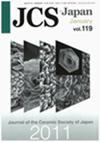ZnS中部分位错本征核结构的直接观察
IF 1.1
4区 材料科学
Q3 MATERIALS SCIENCE, CERAMICS
引用次数: 0
摘要
由于位错的核心结构需要光激发载流子来重建,因此可以通过光照改变化合物半导体材料中位错的迁移率。然而,这种位错核的原子结构尚未被观察到,对其仍知之甚少。本文研究了典型的II-VI型化合物半导体之一ZnS在黑暗条件下的变形,并利用扫描透射电子显微镜(STEM)结合理论计算研究了位错核的原子结构。对锌核部分位错的直接观察表明,锌核部分位错的原子结构与理论预测的位错核基本一致。此外,在观察过程中观察到位错沿滑移面移动。这些结果表明,无电子陷阱的位错是可移动的,可能是黑暗中塑性的起源。本文章由计算机程序翻译,如有差异,请以英文原文为准。
Direct observation of intrinsic core structure of a partial dislocation in ZnS
Mobility of dislocations in compound semiconductor materials can be changed by light illumination because the core structure of dislocations is supposed to be reconstructed by photoexcited carriers. However, the atomic structure of such dislocation cores has not been observed and is still poorly understood. In this study, we introduced dislocations in ZnS, one of the typical II–VI type compound semiconductors, by deformation under darkness, and investigated the atomic structure of the dislocation cores using scanning transmission electron microscopy (STEM) combined with theoretical calculations. Direct observation of the Zn core partial dislocation revealed that its atomic structure is in good agreement with the theoretically predicted dislocation core without electron trapping. Moreover, the dislocations were observed to move along a slip plane during the observation. These results indicate that the electron-trap-free dislocation is mobile and could be the origin of plasticity in the dark.
求助全文
通过发布文献求助,成功后即可免费获取论文全文。
去求助
来源期刊

Journal of the Ceramic Society of Japan
工程技术-材料科学:硅酸盐
CiteScore
2.10
自引率
18.20%
发文量
170
审稿时长
2 months
期刊介绍:
The Journal of the Ceramic Society of Japan (JCS-Japan) publishes original experimental and theoretical researches and reviews on ceramic science, ceramic materials, and related fields, including composites and hybrids. JCS-Japan welcomes manuscripts on both fundamental and applied researches.
 求助内容:
求助内容: 应助结果提醒方式:
应助结果提醒方式:


